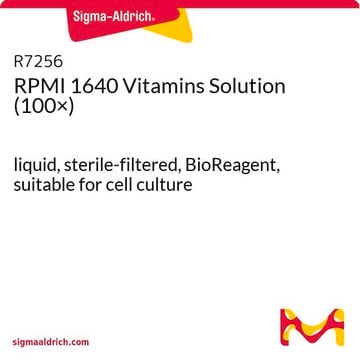M3817
MegaCell™ RPMI-1640 Medium
without L-glutamine, liquid, sterile-filtered, suitable for cell culture
Sign Into View Organizational & Contract Pricing
All Photos(1)
About This Item
UNSPSC Code:
12352207
NACRES:
NA.75
Recommended Products
sterility
sterile-filtered
form
liquid
technique(s)
cell culture | mammalian: suitable
impurities
endotoxin, tested
components
L-glutamine: no
shipped in
ambient
storage temp.
2-8°C
General description
MegaCell™ is a line of versatile media, formulated to significantly reduce the amount of serum required for cultivating mammalian cells in vitro. It is effective as a basal formulation for the growth and maintenance of adherent or suspension cell lines. When supplemented with 3% fetal bovine serum (FBS), MegaCell supports proliferative rates and maximal cell densities comparable, and in some cases superior, to the conventional basal formulation supplemented with 10% fetal bovine serum.
Application
MegaCell™ RPMI-1640 Medium has been used:
- as a component of the TSC medium for culturing trophoblast stem cells (TSC)
- as a component of 25 ng/ml FGF4 and 1 g/ml heparin (TSF4H medium) for culturing TSCs
- as a component of embryo-like structures (ETS) embryo medium and TS cell medium for culturing embryonic stem cells (ESCs) and TSCs
Reconstitution
Supplement with 4 mM L-glutamine (20 ml of 200 mM solution, G7513)
Legal Information
Sigma-Aldrich uses the MegaCell trademark pursuant to an agreement with Promega Corporation.
MegaCell is a trademark of Promega Corp.
also commonly purchased with this product
Product No.
Description
Pricing
Storage Class
10 - Combustible liquids
wgk_germany
WGK 3
flash_point_f
Not applicable
flash_point_c
Not applicable
Certificates of Analysis (COA)
Search for Certificates of Analysis (COA) by entering the products Lot/Batch Number. Lot and Batch Numbers can be found on a product’s label following the words ‘Lot’ or ‘Batch’.
Already Own This Product?
Find documentation for the products that you have recently purchased in the Document Library.
Customers Also Viewed
Sarah Ellys Harrison et al.
Nature protocols, 13(7), 1586-1602 (2018-07-11)
Mammalian embryogenesis requires the coordination of embryonic and extra-embryonic tissues to enable implantation into the uterus and post-implantation development to establish the body plan. Mouse embryonic stem cells (ESCs) are a useful tool for studying pluripotent embryonic tissue in vitro.
Nina S Corsini et al.
Cell stem cell, 22(4), 543-558 (2018-04-07)
Stem cell-specific transcriptional networks are well known to control pluripotency, but constitutive cellular processes such as mRNA splicing and protein synthesis can add complex layers of regulation with poorly understood effects on cell-fate decisions. Here, we show that the RNA
Berna Sozen et al.
Developmental cell, 51(6), 698-712 (2019-12-18)
Mammalian blastocysts comprise three distinct cell lineages essential for development beyond implantation: the pluripotent epiblast, which generates the future embryo, and surrounding it the extra-embryonic primitive endoderm and the trophectoderm tissues. Embryonic stem cells can reintegrate into embryogenesis but contribute
Jinhong Meng et al.
PloS one, 6(3), e17454-e17454 (2011-03-17)
Stem cell transplantation is a promising potential therapy for muscular dystrophies, but for this purpose, the cells need to be systemically-deliverable, give rise to many muscle fibres and functionally reconstitute the satellite cell niche in the majority of the patient's
Our team of scientists has experience in all areas of research including Life Science, Material Science, Chemical Synthesis, Chromatography, Analytical and many others.
Contact Technical Service





